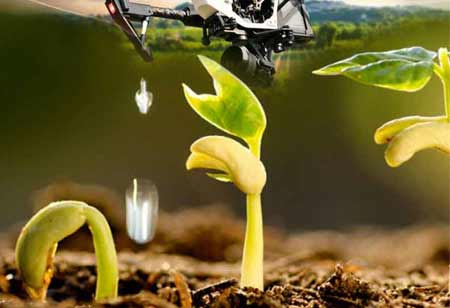Thank you for Subscribing to Agri Business Review Weekly Brief
Top 5 Benifits Of Vertical Hydroponic Farming
Hydroponics & Vertical growing method allows you to cultivate various produce, from microgreens and salad greens to strawberries and tomatoes.

By
Agri Business Review | Tuesday, December 20, 2022
Stay ahead of the industry with exclusive feature stories on the top companies, expert insights and the latest news delivered straight to your inbox. Subscribe today.
The ability to produce high yields of nutritious food with less water will also become important as populations increase and many regions suffer from water insecurity.
FREMONT, CA: Hydroponics & Vertical growing method allows you to cultivate various produce, from microgreens and salad greens to strawberries and tomatoes.
Gradually, there is a drive to enhance agricultural efficiency and lower food production costs to feed our rapidly growing global population while minimizing environmental degradation.
What does hydroponic mean?
Hydroponics is the method of using water to labor in beneficial ways. Using pumps and gravity, we can channel water through a system, delivering nutrients directly to the roots of plants in the absence of soil.
1. Hydroponics Saves Water
Growing with hydroponics can decrease water use considerably. The principal water losses (in a system with no leaks) will be because of evaporation and transpiration. The extensive majority of water absorbed by plants will be lost to transpiration through their leaves. Most systems employ a recirculating system, where plants absorb the required water, and any run-off is channeled back to a reservoir.
To make a closed system, some growers are now using water vapor condensers in their ventilation systems to capture and return the water into their systems. This can reduce the use to 5-10% of traditional outdoor growing uses.
2. Vertical, hydroponic systems are space efficient
Besides using hydroponic methods, many growers are growing vertically to use space more effectively. We do this ourselves at Paddington rooftop farm: a vertical system enables us to grow up to 500% more leafy greens than a horizontal system.
Vertical systems have the added advantage of requiring less arduous labor since there is no bending over when managing and harvesting plants. They are ideal for homes, too. Even the lowest flat or apartment has a wall on which a hydroponic system can be mounted or placed against.
Also, when a nutrient solution is delivered directly to roots without soil, the roots can grow far more compactly and close together. Root systems of plants constitute a substantial amount of the plant's biomass; when utilizing hydroponics systems, the dense root growth enables us to cultivate more plants in smaller spaces.
3. Farming in cities better the resilience of our food supply
As per the UN, 55% of the world's population lives in cities, and with this project to meet 68% by 2050, it makes sense to grow to produce close to these population centers to build resistance to food insecurity. If we wanted to grow lots of produce utilizing soil, most cities would not be able to allocate adequate outdoor green space for this.
Still, there is lots of space where soilless hydroponic systems can be placed in cities. A recent Institute for Sustainable Food study found that Sheffield city center has 32 hectares of flat roof space, which can be utilized for soil-free farming.
They found that utilizing three-quarters of this space can feed 60% of Sheffield's population with one of their five daily. This shows how much we could meaningfully produce in vacant urban spaces. This product can be delivered locally with fewer food miles and a smaller carbon footprint.
4. You can grow without soil
Growing with soil is excellent when we have land with healthy soil - full of organic matter and soil biota. Still, this is becoming a scarce resource because of poor agricultural and land management practices. It takes time to transform your soil, and importing soil is costly and labor-intensive.
There are also several locations across the globe with confined arable land (e.g., arid countries); several regions have very sandy soils, which are not worth farming because they leach out so much water and nutrients. Soilless farming is a fine solution where soil resources are not available.
Advantageous relationships between plants and soil biota, like bacteria and fungi, do not require to be lost in soilless systems. There are multiple supplements on the market which contain advantageous bacteria and mycorrhizae. When included in our water, these microorganisms create synergetic relationships with the plant roots and grow resistance to pathogens and root-born diseases. The mycorrhizae expand the root surface area and expand plant nutrient uptake.
5. Plants grow faster and greater with hydroponics
We have incredible control over the conditions plants grow in in controlled hydroponic systems. The nutrient solution can be adjusted to offer the optimum conditions for growing plants, thus leading to faster growth and bigger plants.
This can be hard to optimize when growing in soil as different plants have specific needs and soil types vary greatly. The primary two measurements we look to control are the number of nutrients concentrated in the water (with Electrical Conductivity, EC) and the pH of the solution.
You can also transform the amounts and types of nutrients for different stages of a plant's growth. For instance, early in a strawberry plant's life cycle, you should grow them with nutrients to enhance vegetative growth (leaves and stems). This will be greater in nitrogen. Then nutrients are transformed when plants begin their fruiting cycle to guarantee you get a large fruit set. These are normally lower in nitrogen and high in phosphorus and potassium.
Conclusion
Vertical, hydroponic farming has several benefits we can hold onto. Through CEA, we can grow in all corners of the globe, especially where there are little soil resources or harsh climatic conditions. Bringing food production into cities by employing vacant land for commercial production and community gardens offers great potential to build flexibility to food insecurity.





